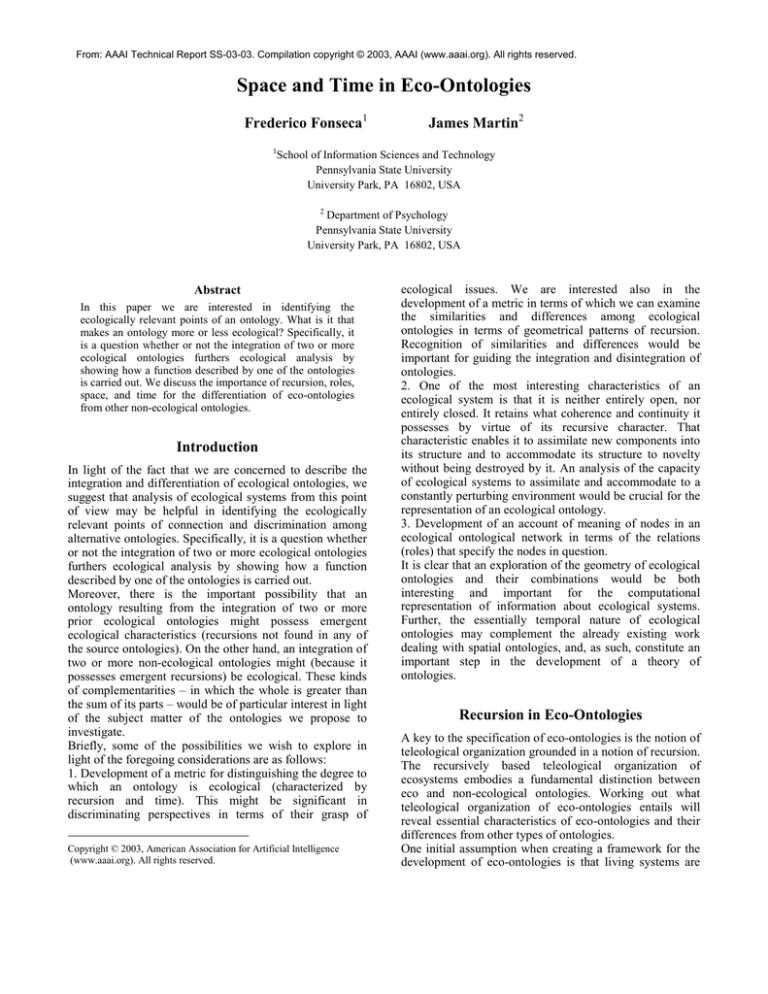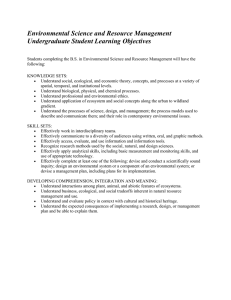
From: AAAI Technical Report SS-03-03. Compilation copyright © 2003, AAAI (www.aaai.org). All rights reserved.
Space and Time in Eco-Ontologies
Frederico Fonseca1
James Martin2
1
School of Information Sciences and Technology
Pennsylvania State University
University Park, PA 16802, USA
2
Department of Psychology
Pennsylvania State University
University Park, PA 16802, USA
Abstract
In this paper we are interested in identifying the
ecologically relevant points of an ontology. What is it that
makes an ontology more or less ecological? Specifically, it
is a question whether or not the integration of two or more
ecological ontologies furthers ecological analysis by
showing how a function described by one of the ontologies
is carried out. We discuss the importance of recursion, roles,
space, and time for the differentiation of eco-ontologies
from other non-ecological ontologies.
Introduction
In light of the fact that we are concerned to describe the
integration and differentiation of ecological ontologies, we
suggest that analysis of ecological systems from this point
of view may be helpful in identifying the ecologically
relevant points of connection and discrimination among
alternative ontologies. Specifically, it is a question whether
or not the integration of two or more ecological ontologies
furthers ecological analysis by showing how a function
described by one of the ontologies is carried out.
Moreover, there is the important possibility that an
ontology resulting from the integration of two or more
prior ecological ontologies might possess emergent
ecological characteristics (recursions not found in any of
the source ontologies). On the other hand, an integration of
two or more non-ecological ontologies might (because it
possesses emergent recursions) be ecological. These kinds
of complementarities – in which the whole is greater than
the sum of its parts – would be of particular interest in light
of the subject matter of the ontologies we propose to
investigate.
Briefly, some of the possibilities we wish to explore in
light of the foregoing considerations are as follows:
1. Development of a metric for distinguishing the degree to
which an ontology is ecological (characterized by
recursion and time). This might be significant in
discriminating perspectives in terms of their grasp of
Copyright © 2003, American Association for Artificial Intelligence
(www.aaai.org). All rights reserved.
ecological issues. We are interested also in the
development of a metric in terms of which we can examine
the similarities and differences among ecological
ontologies in terms of geometrical patterns of recursion.
Recognition of similarities and differences would be
important for guiding the integration and disintegration of
ontologies.
2. One of the most interesting characteristics of an
ecological system is that it is neither entirely open, nor
entirely closed. It retains what coherence and continuity it
possesses by virtue of its recursive character. That
characteristic enables it to assimilate new components into
its structure and to accommodate its structure to novelty
without being destroyed by it. An analysis of the capacity
of ecological systems to assimilate and accommodate to a
constantly perturbing environment would be crucial for the
representation of an ecological ontology.
3. Development of an account of meaning of nodes in an
ecological ontological network in terms of the relations
(roles) that specify the nodes in question.
It is clear that an exploration of the geometry of ecological
ontologies and their combinations would be both
interesting and important for the computational
representation of information about ecological systems.
Further, the essentially temporal nature of ecological
ontologies may complement the already existing work
dealing with spatial ontologies, and, as such, constitute an
important step in the development of a theory of
ontologies.
Recursion in Eco-Ontologies
A key to the specification of eco-ontologies is the notion of
teleological organization grounded in a notion of recursion.
The recursively based teleological organization of
ecosystems embodies a fundamental distinction between
eco and non-ecological ontologies. Working out what
teleological organization of eco-ontologies entails will
reveal essential characteristics of eco-ontologies and their
differences from other types of ontologies.
One initial assumption when creating a framework for the
development of eco-ontologies is that living systems are
auto-poetic – self-organizing (Maturana and Varela 1980;
Kauffman 1995). Kant (2000) was the first to introduce
this hypothesis. He viewed biological systems as having
components that are, recursively, both means and ends in
relation to one another. In this way, a living system,
whether the organs of an individual organism or
individuals comprising a whole, symbiotic, eco-system, is
interpretable in terms of teleological categories. We may
ask, “What function does this organ or organism serve?”
Kant’s point in this regard concerns what might be called
‘levels of analysis.’ If one is interested in biology, as
opposed to physics, the questions one wants to ask have to
do with the function of an organ or organism in the larger
whole of which it is a part.
Space and Time in Ecological Borders
We can consider space and time as two important
dimensions to explain the interactions between an
ecological environment and its surroundings.
Regarding where the disturbance occurs we can have:
• the disturbance is external to the system. It
interacts with the system but without penetrating
it, at least in a permanent character.
• the disturbance penetrates the system. The new
element crossed the system boundary and it now
in the system in a definite way.
Regarding the duration of the disturbance we can have:
• some disturbances can be of an ephemeral
character;
• some disturbances have a permanent character or
a recursive one.
When the disturbance is ephemeral and internal the
tendency of an ecological system is to absorb locally the
disturbance without propagating the instability to the
whole system. When the disturbance occurs externally to
the system and it is ephemeral we can consider it only a
distraction without any consequences.
The permanent disturbance causes structural changes in the
system. When they are internal to the systems, the two
system learn how to live with each other and the
relationship is beneficial to both of them. This process is
called symbiosis.
The second type of permanent disturbance is between a
system and an external agent. Since its character is
permanent or at least of a recurrent character the system
needs to learn how to live with it. What happens then is
what Maturana and Varela (1987) call structural coupling.
Structural coupling is the resulting change in the structure
of each of the two interacting living systems. The
structures in each system change as a result of the presence
of the other system. As Maturana and Varela stress the
change is not made by the other system being instead
started by it.
Roles
It is very interesting that this sort of analysis introduces, in
a natural way, a teleological dimension into the description
of an ecological system. Under its guidance, one begins to
see an ecological sense in which it is appropriate to ask
what something is for, or what its function (or, role) might
be in the ecological system. Of course, if one ignores the
reciprocal means-end analysis Kant pointed to, one might
describe the causal antecedents of any number of events
but fail to see the ecological system. Such an investigator
would fail to identify the ecologically relevant events or
relations, or to distinguish them from the indefinitely large
set of events and relations that are of mi-nor importance in
understanding the ecological system. For example, in
examining the mammalian body there are many relatively
subsidiary questions one might ask about the heart – such
as what color it is when viewed on the laboratory
dissection table. On the other hand, if one knows that the
function, or role, of the heart is to move the blood, and that
it is through that function that the heart enables the
continued existence of the other organs of the body, and
thus its own continued existence as well, then one is
directed to ask questions concerning the heart that are
relevant to the function of the whole body of which it is a
part. Specifically, one is led to ask how the heart moves the
blood. The investigator will be led to question of the role
of a structure or relation in the function of an ecological
system as a whole.
The Essentially Temporal Character of EcoOntologies
Ecological ontologies, then, must be represented in terms
that allow us to capture their genuinely self-organizing,
ecological nature (i.e., the ecological level of analysis).
More formally, such self-organizing systems have the
characteristic of recursion in the sense that
A=>B=>C=>A=>B=>, etc. This description reveals the
essentially temporal character of eco-ontologies. In
contrast with the essentially spatial character of geoontologies, eco-ontologies are fundamentally temporal in
character. The spatial character of geo-ontologies,
ontologies for the geographic world, contributes to the
hierarchical organization of geo-systems. The temporal
character of eco-ontologies on the other hand is a function
of the recursive process that is essential to their definition.
There is, of course, a possibility of hierarchical relations in
eco-ontologies. However, in this case the hierarchies are
functional and dynamic in nature. For example, at one
level of analysis, the heart may be seen as moving the
blood. At a subordinate level of analysis, moving the blood
may be seen as pumping the blood, etc.
The special importance of time eco-ontologies derives
from the fact that the life course for living beings is
structured in terms of time. Today, for a living being, is
different from yesterday because he/she is older.
Moreover, many living beings learn from their
experiences, which makes today even more different from
yesterday from their point of view. Organisms in an
ecological system have a short span of life com-pared to
regular geographic features that can last millions of years.
Thus, while for some purposes it may by possible to ignore
the temporal dimension in constructing geo-ontologies, the
circular causal chains that make for ecological selfcausation re-quire that eco-ontologies represent the
temporal character of ecological systems.
Conclusions
In this paper we have elaborated some of the fundamental
characteristics of ecological ontologies and drew attention
to the formal differences between ecological and nonecological ontologies. The presence of recursion, time, and
of nodes representing a function are the three main
characteristics of an ecological ontology.
We think that focusing the study of how to represent
formally these main components of an ecological ontology
we will be able to build metrics to examine similarities and
differences between (1) different eco-ontologies and (2)
eco-ontologies and non-ecological ontologies.
References
Kant, I. (2000) The Critique of Judgment. Prometheus
Books, Amherst, N.Y.
Kauffman, S. A. (1995) At home in the universe : the
search for laws of self-organization and complexity.
Oxford University Press, New York.
Maturana, H. R. and Varela, F. J. (1980) Autopoiesis and
Cognition: the Realization of the Living. D. Reidel Pub.
Co., Dordrecht, Holland ; Boston.
Maturana, H. R. and Varela, F. J. (1987) The Tree of
Knowledge:
the Biological Roots of Human
Understanding. New Science Library: Distributed in the
United State by Random House, Boston.








